ikfoundation.org
Promoting Natural & Cultural History



ESSAYS |
TAPE LOOM WEAVING
– and its Traditions in the North American Colonies
This second observation from North America includes a portrait from 1773, a box tape loom dated 1794, weaving from Philadelphia in July 2014 and some examples of its European textile heritage. It can however not be stated with absolute certainty how, when or by whom this type of weaving was introduced, but there are clear indications that the knowledge of tape loom weaving in this manner had its origins from the early American settlers travelling from Germany or the Scandinavian countries to the Philadelphia area, from here the knowledge was probably spread to other parts of the American colonies. The aim of this text is to give a brief history of this particular style of box looms and belt-strapped rigid heddle models – looms which have been in practice on both sides of the Atlantic up until today, particularly within a revival of historical handcraft and reenactment.
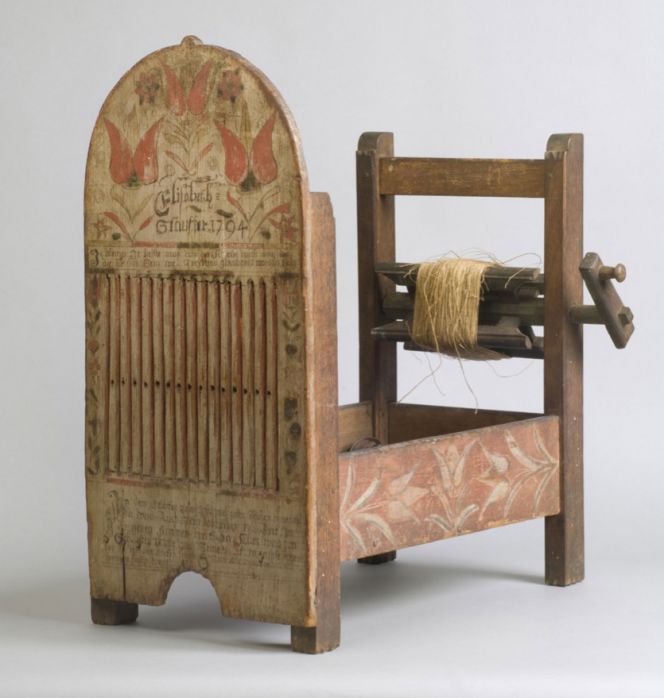 A tape loom with spools made in Milford Township, Pennsylvania. The lettering on the loom reads “Elizabeth Stauffer 1794” followed by a text in German mainly wishing her a good life. The German verse is further proof for this loom model’s origin, also to be compared with image (3) below showing historical reenactment weaving in the same type of loom in present-day Philadelphia. Courtesy of: Philadelphia Museum of Art, US.
A tape loom with spools made in Milford Township, Pennsylvania. The lettering on the loom reads “Elizabeth Stauffer 1794” followed by a text in German mainly wishing her a good life. The German verse is further proof for this loom model’s origin, also to be compared with image (3) below showing historical reenactment weaving in the same type of loom in present-day Philadelphia. Courtesy of: Philadelphia Museum of Art, US.Ribbons formed a noteworthy component for clothing during centuries in many cultures, which was not only used as decoration but also to hide and reinforce seams, or to tie together parts of garments, hold up stockings etc. The weaving of decorative as well as practical ribbons is quite an extensive subject within the history of textiles, which will be discussed here with a couple of detailed observations. It can be noted that the type of box tape loom illustrated above seems to have been very rare in Scandinavia based on preserved tools for ribbon weaving from the 18th and 19th centuries – in these countries the rigid heddle loom with a back-strap was used instead. On the other hand, in present-day Germany and some other neighbouring countries, the box model was widespread, so it must be concluded that the most probable direct link between this type of box loom has its origin from the many Germans who emigrated to the Philadelphia area during the 17th and 18th centuries.
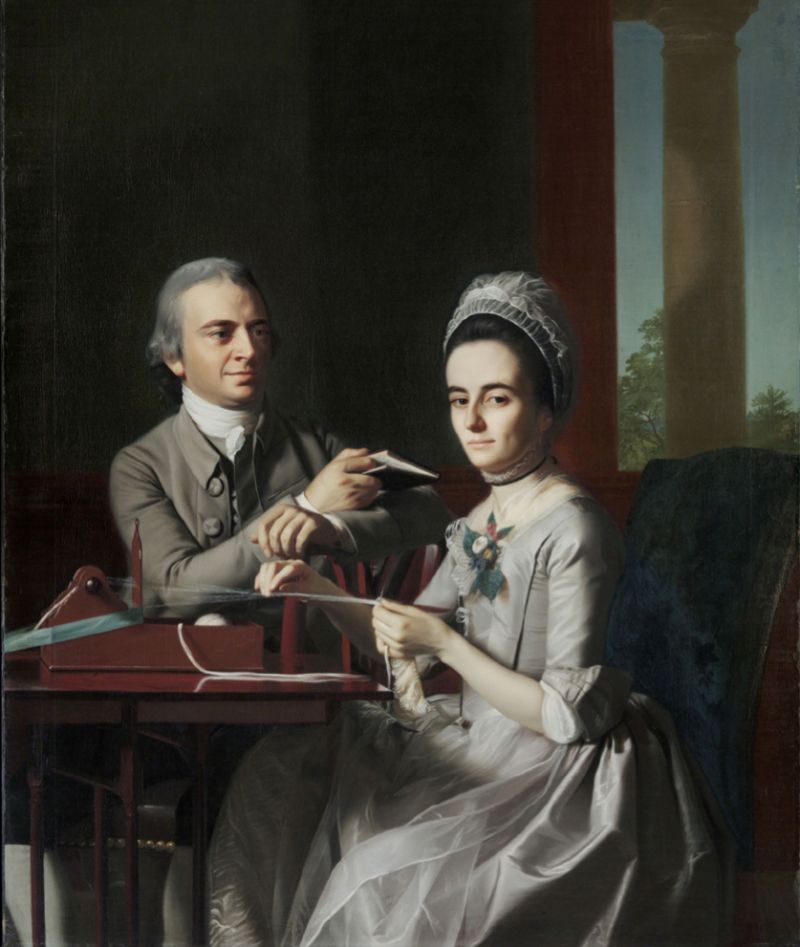 Portrait of Mr and Mrs Thomas Mifflin (Sarah Morris) by John Singleton Copley. The Mifflin couple were Philadelphians, sitting for this portrait with “the tape loom” in Boston, Massachusetts in 1773. Because of their long journey between the two cities (c. 500 km) the loom was probably not Sarah’s own, but instead added for a purpose in the picture. The museum website information emphasises here: ‘Sarah’s handwork may symbolise the couple’s patriotic endorsement of the nonimportation agreements signed by American colonists resolved to boycott English goods’. The painting is also important evidence for that this type of loom was used in more than Pennsylvania in the 1770s, pointing at that the practise of weaving in such a loom already by now had been a widespread tradition in the American colonies for many years. It is also of interest to note that the depicted Sarah holds the warp threads/ribbon in exactly the same way as the weaver does more than 240 years later during the summer of 2014 in Philadelphia, on the image below! Courtesy of: Philadelphia Museum of Art, US.
Portrait of Mr and Mrs Thomas Mifflin (Sarah Morris) by John Singleton Copley. The Mifflin couple were Philadelphians, sitting for this portrait with “the tape loom” in Boston, Massachusetts in 1773. Because of their long journey between the two cities (c. 500 km) the loom was probably not Sarah’s own, but instead added for a purpose in the picture. The museum website information emphasises here: ‘Sarah’s handwork may symbolise the couple’s patriotic endorsement of the nonimportation agreements signed by American colonists resolved to boycott English goods’. The painting is also important evidence for that this type of loom was used in more than Pennsylvania in the 1770s, pointing at that the practise of weaving in such a loom already by now had been a widespread tradition in the American colonies for many years. It is also of interest to note that the depicted Sarah holds the warp threads/ribbon in exactly the same way as the weaver does more than 240 years later during the summer of 2014 in Philadelphia, on the image below! Courtesy of: Philadelphia Museum of Art, US.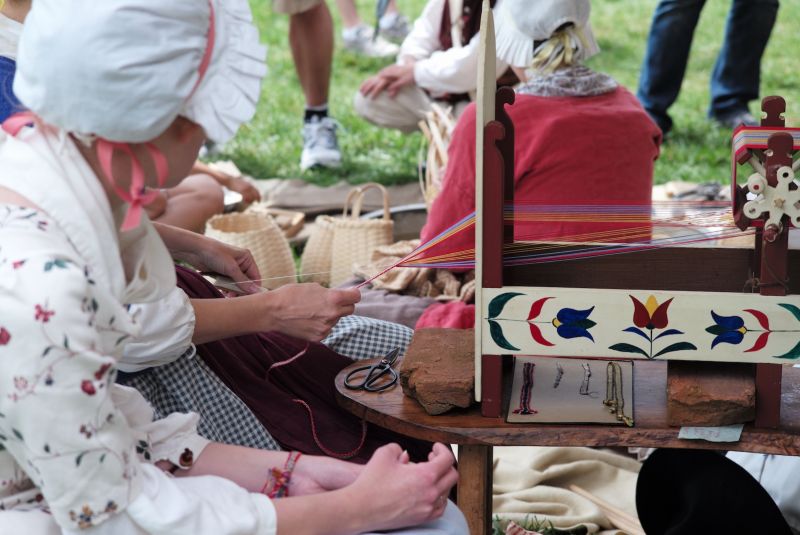 Tape loom weaving – historical reenactment on 4th July 2014 at National Constitution Centre in Philadelphia. Notice the loom design as well as the weaving technique and the clear resemblance with the two images above depicting 18th century box tape looms. Photo: The IK Foundation, London.
Tape loom weaving – historical reenactment on 4th July 2014 at National Constitution Centre in Philadelphia. Notice the loom design as well as the weaving technique and the clear resemblance with the two images above depicting 18th century box tape looms. Photo: The IK Foundation, London.The two parallel and closely connected traditions – the box-style tape loom and the typical Scandinavian rigid heddle loom – are, on the whole, working in a similar manner, and the tools were predominately made as domestic handcraft in various models and sizes. For the first mentioned, the warp/ribbon is stretched by the weaver’s hand to get the correct tension while the weft is picked with the other hand, a relatively slow and partly limited weaving technique, but the advantage is the stable box model. A method in use since at least the second half of the 18th century, judging by the portrait above from 1773. On the other hand, the belt strapped rigid heddle loom makes both hands available, which means that the weaving is faster, which makes it easier to design more advanced patterned ribbons.
![A rigid heddle loom made of antlers [probably reindeer] used in the early 19th century by the Sami people of northern Norway – engraved with the year “1810”. Similar simple tape looms of various sizes were in use in many areas of Scandinavia, most often made of wood but also antlers, bone and metal which were other durable materials. The weaver fastened the warp in a hook, door handle or similar arrangement and attached the other side of the warp in a belt around her/his waist. Courtesy of: the Nordic Museum, Stockholm, Sweden (no. 69998).](https://www.ikfoundation.org/uploads/image/band-loom-4-jpg-664x462.jpg) A rigid heddle loom made of antlers [probably reindeer] used in the early 19th century by the Sami people of northern Norway – engraved with the year “1810”. Similar simple tape looms of various sizes were in use in many areas of Scandinavia, most often made of wood but also antlers, bone and metal which were other durable materials. The weaver fastened the warp in a hook, door handle or similar arrangement and attached the other side of the warp in a belt around her/his waist. Courtesy of: the Nordic Museum, Stockholm, Sweden (no. 69998).
A rigid heddle loom made of antlers [probably reindeer] used in the early 19th century by the Sami people of northern Norway – engraved with the year “1810”. Similar simple tape looms of various sizes were in use in many areas of Scandinavia, most often made of wood but also antlers, bone and metal which were other durable materials. The weaver fastened the warp in a hook, door handle or similar arrangement and attached the other side of the warp in a belt around her/his waist. Courtesy of: the Nordic Museum, Stockholm, Sweden (no. 69998).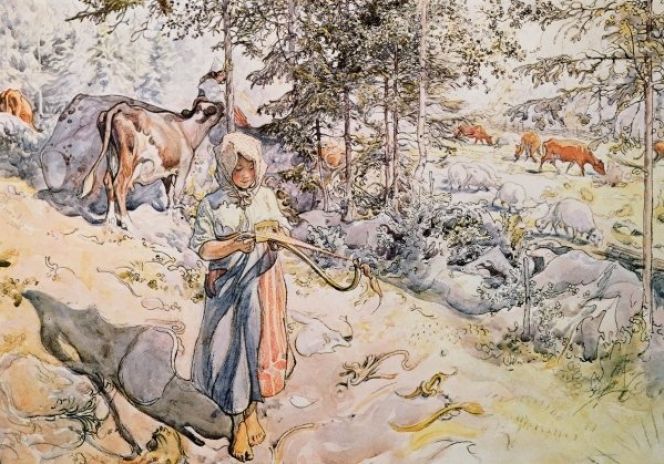 Girl weaving a ribbon in a type of rigid heddle loom in Dalarna, Sweden. It was probably the norm to sit down during the weaving, however with specially made tools as here depicted in 1905 it was possible to walk and combine the ribbon weaving with other tasks. (Artist: Carl Larsson (1853-1919), coloured lithograph in Public Domain).
Girl weaving a ribbon in a type of rigid heddle loom in Dalarna, Sweden. It was probably the norm to sit down during the weaving, however with specially made tools as here depicted in 1905 it was possible to walk and combine the ribbon weaving with other tasks. (Artist: Carl Larsson (1853-1919), coloured lithograph in Public Domain).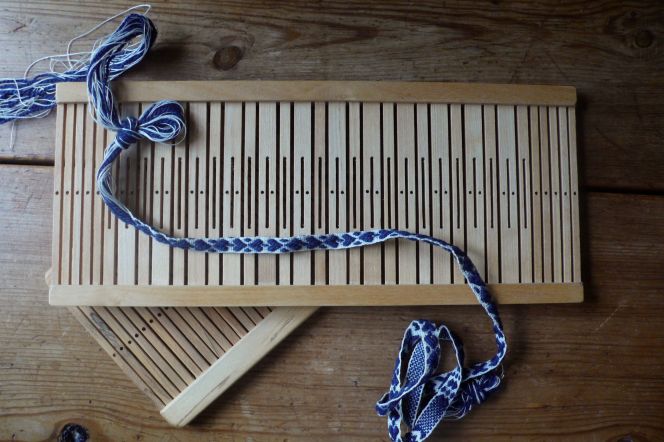 As a comparison; two modern Swedish rigid heddle looms made after older models. The wider loom have been used for ribbons, like the illustrated heart-shaped one of blue wool and linen. While the narrower variation of loom can be used for plain as well as ornamented designs. Photo & woven ribbon: Viveka Hansen.
As a comparison; two modern Swedish rigid heddle looms made after older models. The wider loom have been used for ribbons, like the illustrated heart-shaped one of blue wool and linen. While the narrower variation of loom can be used for plain as well as ornamented designs. Photo & woven ribbon: Viveka Hansen.Sources:
- DigitaltMuseum (Search term: “vävsked”).
- Hansen, Viveka (Practical experience and reproductions of weaving in a rigid heddle loom with a back strap: Swedish models).
- National Constitution Centre, Philadelphia, Pennsylvania, US (Historical reenactment July 4, 2014).
- Nylen, Anna-Maja, Swedish Handcraft, 1976.
- Philadelphia Museum of Art, Philadelphia, Pennsylvania, US, Online Collection (Oil on Ticking & Tape Loom).
ESSAYS
The iTEXTILIS is a division of The IK Workshop Society - a global and unique forum for all those interested in Natural & Cultural History from a Textile Perspective.
Open Access essays - under a Creative Commons license and free for everyone to read - by Textile historian Viveka Hansen aiming to combine her current research and printed monographs with previous projects dating back to the late 1980s. Some essays also include unique archive material originally published in other languages, made available for the first time in English, opening up historical studies previously little known outside the north European countries. Together with other branches of her work; considering textile trade, material culture, cloth manufacturing, fashion, natural dyeing and the fascinating world of early travelling naturalists – like the "Linnaean network" – from a Global history perspective.
For regular updates, and to make full use of iTEXTILIS' possibilities, we recommend fellowship by subscribing to our monthly newsletter iMESSENGER.
been copied to your clipboard




– a truly European organisation since 1988
Legal issues | Forget me | and much more...
It is free to use the information/knowledge in The IK Workshop Society so long as you follow a few rules.
 LEARN MORE
LEARN MORE








